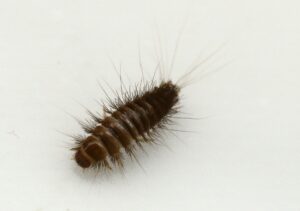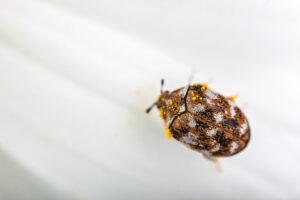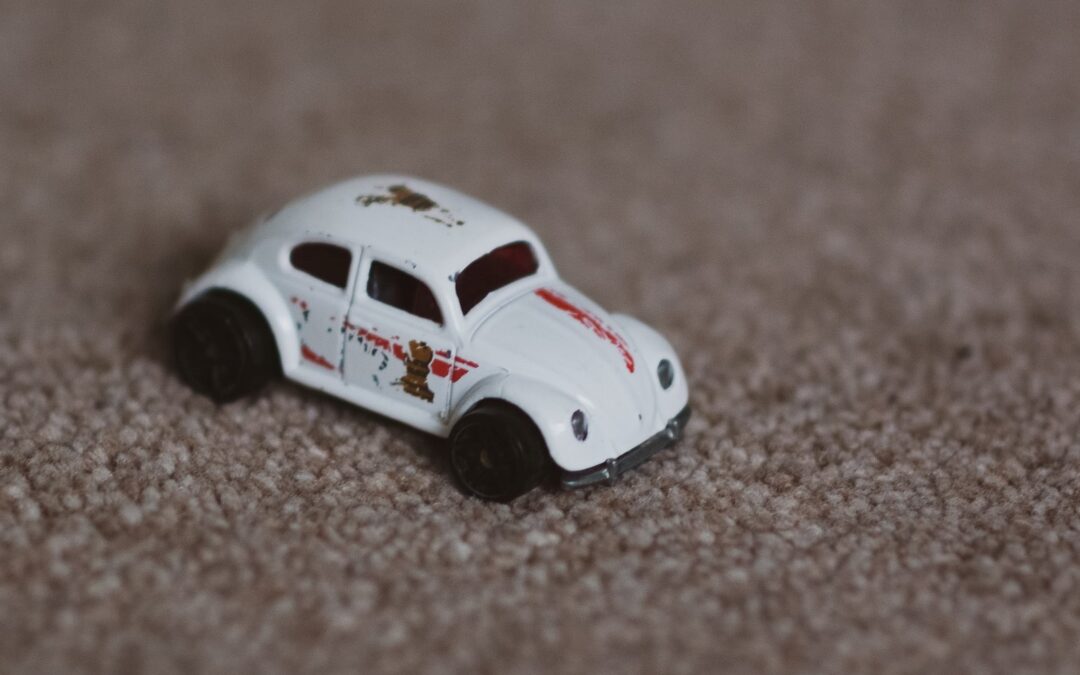Living with insects is a fact of life.
Little creatures are always around us, playing crucial roles in their (and our) ecosystem. Multitudes of tiny organisms being born, feeding, being fed upon, reproducing, and dying. At which point a whole other group of creatures moves in to break down that which has died into its constituent parts. Raw materials re-absorbed into the nutrient pool to be sent back up the food chain. The only certainty being that they will return to the bottom once again. It is one of the latter that we’ll talk about today. A decomposer that is almost always close by but goes largely unnoticed until they become a problem. The Carpet Beetle.
Like I stated, living with insects is a fact of life and that is particularly true with these. Working in pest control, it feels like I could find one or two Carpet Beeltes in any home or building I inspect. These little bugs belong to the family Dermestidae, or “skin beetle”, which is a reference to one of its favorite meals, and there is plenty to snack on in even the cleanest homes. Them being widespread makes sense given the availability of food (for the larvae) pretty much everywhere. The name “Carpet beetle” is kind of a misnomer at this point because most modern carpets used today are made from synthetic fibers. This particular beetle earned its name from infesting the wool and silk carpets of old. Even though they don’t infest carpets much anymore, their numbers can still get out of control and that’s when people take notice and call us for help.

Carpet Beetle Larvae by Golda Falk from Pixabay
I want to focus on the Varied Carpet Beetle because it’s the most common species around Western Oregon. After we receive a call for Carpet Beetles, one of our highly skilled technicians gets onsite and is usually presented with one of two things: a sample of a tiny round beetle, 1/10 of an inch long, with yellow, brown, and white scales on its elytra, (these scales can wear off with age leaving the beetle mostly black) or a brown striped spikey haired larva. These are the adult and immature larval versions of the same creature. In fact, adult Carpet Beetles don’t even eat fabrics, preferring pollen and nectar they are often found outdoors. It’s when they get indoors and lay their eggs that they become a problem. The adult will lay eggs on a food source that could be anything from pet dander to a dead dried-up mouse in the wall, to a yellowjacket nest that is in the attic. Taxidermy and down-stuffed pillows are fair game as well. I’ve even seen them in pantries infesting dry stored goods like noodles and herbs. Pretty much any natural fiber, grain, or dry animal protein is a suspect.
Once the eggs hatch and the pupae emerge, they go to work. They devour the surrounding food source, grow in size, and gain energy until they pupate. This can take 200-600 days depending on conditions, at which point they find a place to pupate. That is a huge time range! It can take well over a year for these insects to go from egg hatch to adult.
Ten or so days later, BAM, adult carpet beetles emerge. This usually happens in the late spring or early summer, and they leave searching for the nectar and pollen that they need to survive (remember, the adults don’t have the same diet as the larvae). This is when they are commonly reported. In most cases, the numbers are modest and, because the adult beetle is attracted to light, they are often found around windows.

Adult Varied Carpet Beetle
So…you find Carpet Beetles inside your home, what do you do now? Luckily, you have made it this far into my article and have earned yourself some helpful hints:
- First and foremost, try to find the source. Finding the source can be difficult to do with small infestations but start with the rooms with the highest activity. Even though the adults may only show up at the windows, do not limit your search to that immediate area. Inspect areas in those rooms that are away from the windows such as inside cupboards, pantries, around light fixtures, exhaust fans, behind furniture or appliances, heat registers, and any crevice that dander or animal hair can collect.
- Sometimes the origin is easy to find like a box of elbow macaroni in the pantry. Sometimes it’s extremely difficult such as a gap around a pipe coming through a wall and you have to open the wall up to remove a three-year-old piece of rat jerky. Regardless, the most effective and lasting way to get rid of Carpet Beetles is to remove the source of the infestation. If this can be done, chemical application is often unnecessary.
- Adhesive traps are readily available and make a great tool to help narrow your search for the source. Place them around the baseboards of the rooms with the activity and check them in a few days or a week. The trap with the highest number of beetles caught will be closest to the source.
- General cleaning and vacuuming of all floors, furniture, and other areas of lint, hair, and dander, will help remove food sources and future breeding sites.
- Protect natural fabrics or any other potential breeding site with a thorough cleaning and proper storage techniques.
- Items that cannot be cleaned (taxidermy or delicate fabrics for example) can sometimes be placed in a freezer for 10-14 days. This will kill any eggs, larvae, or adults present.
There is small comfort, their emergence usually only lasts a couple of weeks. So, with enough vacuuming, you will be rid of them after a while and get some relief until next year. If you need help, contact your local pest control provider. Support local businesses! If you’re in the Willamette Valley, on the Oregon Coast, or in SW Portland, then give Good Earth Pest Company a call. Or you can send us a text, email, or even chat with us using that little blue dot at the bottom right corner of this page. We’re always happy to offer advice and any help we can provide! Or, if you’re like me and just want to nerd out on some carpet beetle information, check out this article from UC Davis that I leaned on heavily. It’s dense in information but lacks the character and grammatical errors that; make my articles so great. Aaaanyway, until next time.
Keep searching!
-Adam



